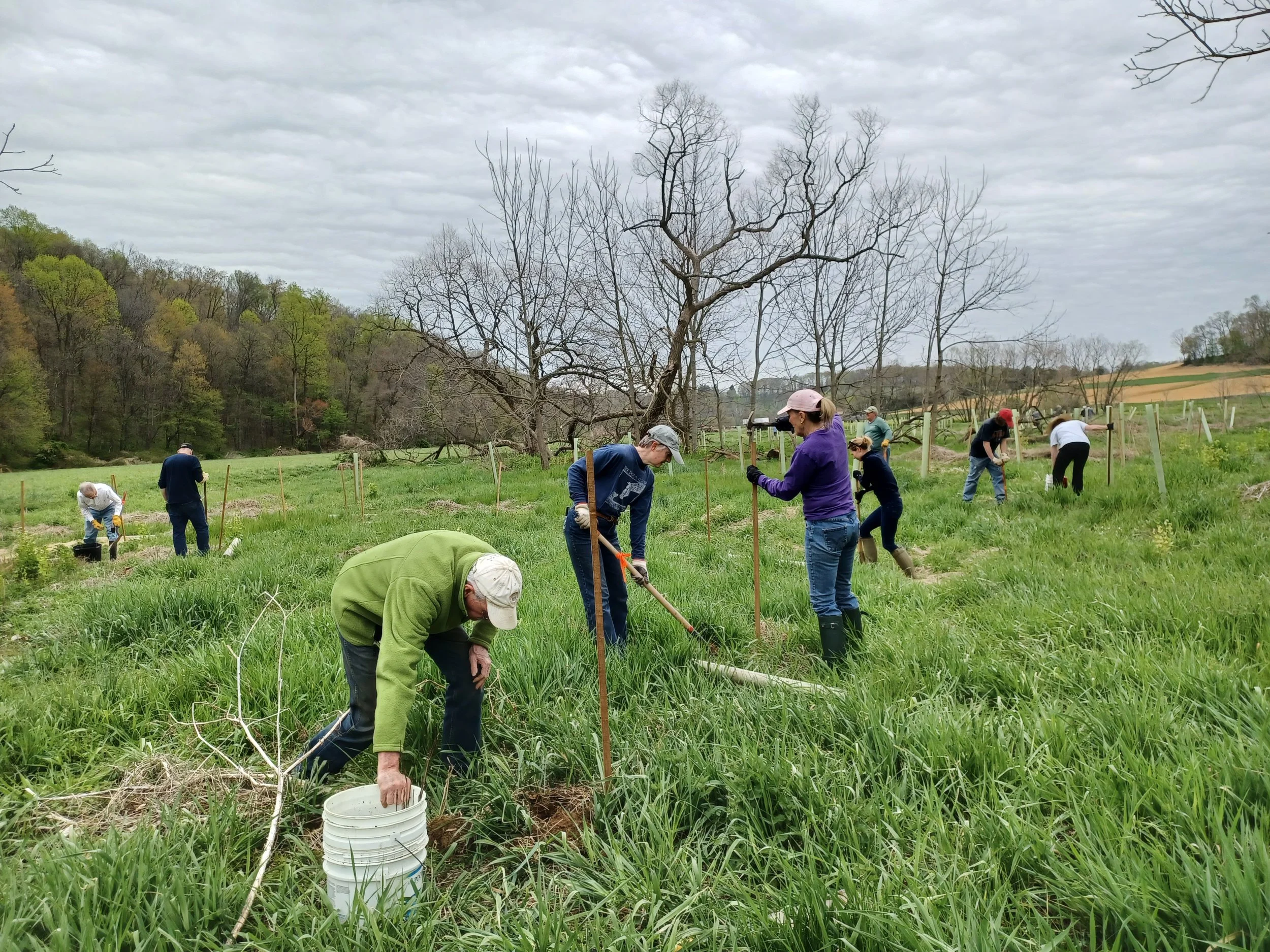
What We Do
2) Stream Monitoring
The Octoraro Watershed Association has maintained a water quality monitoring program since 2017. Our monitoring activities offer participants the opportunity to explore nature along various streams in the Octoraro watershed, which spans an estimated 373 miles of streams. The data we collect as citizen scientists is submitted to the Lancaster County Conservation District (LCCD) and is shared with numerous organizations involved in water quality, including the Alliance for the Chesapeake Bay, Chesapeake Bay Foundation, Pennsylvania DEP, and the United States EPA.
Our water quality monitoring program consists of three components, each providing a unique way to become familiar with the watershed. The Chemistry component involves monthly visits to the streams, while Biology and Habitat assessments occur less frequently due to their complexity.
During our regular monthly visits, teams of 3-5 people measure and record physical characteristics such as width, depth, and surface water flow for each assigned stream. We utilize instruments to measure parameters like dissolved oxygen, pH, conductivity, total dissolved solids, salinity, and turbidity. Water samples are collected and sent to the Chester Water Authority for nitrate, phosphate, and alkalinity determination. New volunteers are always welcome, and training is provided onsite. Your contribution will be meaningful from day one.
The biological component, known as the Index of Biological Integrity (IBI) or macroinvertebrate survey, involves collecting larval insects (macroinvertebrates) that inhabit the water. Volunteers identify and count these insects, and the survey's score is based on the diversity, abundance, and pollution tolerance of the collected bugs. Since many macroinvertebrates spend 1-3 years maturing in the water, this survey provides a comprehensive picture of water quality over time. OWA provides ID sheets to help volunteers identify and enjoy catching these bugs before returning them to the water.
The third component is the habitat assessment, which considers ten different aspects of the stream environment. Factors such as loose or silt-embedded rocks, stream bank erosion, surrounding vegetation, animal access to the water, and artificial bank stabilization are evaluated and scored according to a rubric. The aggregate score indicates the stream's expected ability to support life. This assessment involves some walking and wading along 100 meters of stream.
1) Buffer Planting
Stream buffers play a crucial role in improving the health of our streams and, ultimately, the Chesapeake Bay. An ideal buffer consists of 35 to 100 feet of trees and shrubs on both sides of a stream. Trees provide essential shade, which is vital for maintaining cooler, healthier streams for fish, small creatures, and humans. Fallen leaves in the buffer zone provide food for stream critters, while the roots help stabilize banks, absorb runoff, and prevent excess nutrients from entering the water. Trees also sequester carbon, provide habitat, and serve as a source of food for wildlife.
There is a significant effort by Chesapeake Bay environmental groups, as well as state and federal governments, to plant as many trees and shrubs as possible along the streams that flow into the Bay. Our focus is on the Octoraro watershed, and no stream is too small for our attention. Our goal is to plant a minimum of 35 feet on both sides, which typically involves two rows spaced 15 feet apart. We can secure funding for fencing and stream crossings, and we are always in need of volunteers. Volunteering typically requires about two hours of your time, followed by food and camaraderie.
If you're interested in volunteering, please contact Patty Blakeslee at peb@ueavet.com
To learn more or join our volunteer mailing list, please contact Mary Kay Phillips at mkphillips077@gmail.com.
For additional valuable information, visit the Lancaster County Watersheds website at https://lancasterwatersheds.org/educational-tools/. Two educational presentations particularly useful for volunteers are 'Macroinvertebrates,' which features beautiful bug images, and 'Stream Visual Habitat Assessment,' with helpful descriptions of the factors we consider, supported by photos.
The Octoraro Watershed Association's monitoring program is part of the larger Water Quality Volunteers Coalition (WQVC) overseen by the LCCD. You can find more information at https://lancasterwatersheds.org/volunteer/. We monitor 14 sites, with the majority located in Lancaster County, and some in Chester County and Cecil County, MD.
3) Outreach & Implementation
Outreach and implementation is a vital part of our mission and is multifaceted. For outreach, we engage our membership and the general public through our annual newsletter, quarterly board meetings, annual dinner, stream clean-ups, buffer plantings, public notices regarding issues affecting the Octoraro Watershed, active participation in the Source Water Collaborative group (which brings approximately 20 organizations and governmental agencies together to address issues in the watershed), provide contributions to the Watershed Implementation Plan for our area (by 2025, Pennsylvania must reduce nitrogen pollution levels by 34 million pounds per year; phosphorous levels by .7 million pounds per year; and sediment levels by 531 million pounds per year and the WIP is being designed to help reach that goal) and the annual picnic as well as through social media and our web presence.
In regard to the implementation of best management farming practices, OWA educates all farmers but especially Amish farmers about these. OWA also offers support to find funding sources to implement these practices. Our field workers have provided their expertise to over 500 farms just from 2019 to 2023 and we have been in existence for over 50 years.
Make a Difference
JOIN OWA
VOLUNTEER
DONATE
Be part of the watershed conservation community.
Make a hands-on impact in preserving our environment.
Support our mission to protect and enhance our watersheds.








